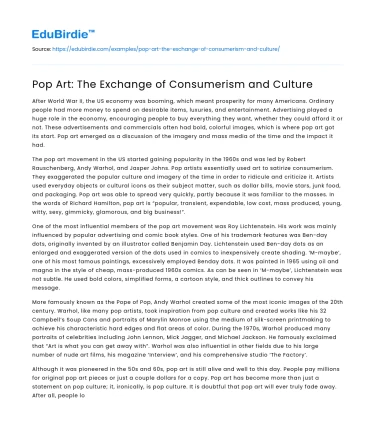After World War II, the US economy was booming, which meant prosperity for many Americans. Ordinary people had more money to spend on desirable items, luxuries, and entertainment. Advertising played a huge role in the economy, encouraging people to buy everything they want, whether they could afford it or not. These advertisements and commercials often had bold, colorful images, which is where pop art got its start. Pop art emerged as a discussion of the imagery and mass media of the time and the impact it had.
The pop art movement in the US started gaining popularity in the 1960s and was led by Robert Rauschenberg, Andy Warhol, and Jasper Johns. Pop artists essentially used art to satirize consumerism. They exaggerated the popular culture and imagery of the time in order to ridicule and criticize it. Artists used everyday objects or cultural icons as their subject matter, such as dollar bills, movie stars, junk food, and packaging. Pop art was able to spread very quickly, partly because it was familiar to the masses. In the words of Richard Hamilton, pop art is “popular, transient, expendable, low cost, mass produced, young, witty, sexy, gimmicky, glamorous, and big business!”.
Save your time!
We can take care of your essay
- Proper editing and formatting
- Free revision, title page, and bibliography
- Flexible prices and money-back guarantee
One of the most influential members of the pop art movement was Roy Lichtenstein. His work was mainly influenced by popular advertising and comic book styles. One of his trademark features was Ben-day dots, originally invented by an illustrator called Benjamin Day. Lichtenstein used Ben-day dots as an enlarged and exaggerated version of the dots used in comics to inexpensively create shading. ‘M-maybe’, one of his most famous paintings, excessively employed Benday dots. It was painted in 1965 using oil and magna in the style of cheap, mass-produced 1960s comics. As can be seen in ‘M-maybe’, Lichtenstein was not subtle. He used bold colors, simplified forms, a cartoon style, and thick outlines to convey his message.
More famously known as the Pope of Pop, Andy Warhol created some of the most iconic images of the 20th century. Warhol, like many pop artists, took inspiration from pop culture and created works like his 32 Campbell’s Soup Cans and portraits of Marylin Monroe using the medium of silk-screen printmaking to achieve his characteristic hard edges and flat areas of color. During the 1970s, Warhol produced many portraits of celebrities including John Lennon, Mick Jagger, and Michael Jackson. He famously exclaimed that “Art is what you can get away with”. Warhol was also influential in other fields due to his large number of nude art films, his magazine ‘Interview’, and his comprehensive studio ‘The Factory’.
Although it was pioneered in the 50s and 60s, pop art is still alive and well to this day. People pay millions for original pop art pieces or just a couple dollars for a copy. Pop art has become more than just a statement on pop culture; it, ironically, is pop culture. It is doubtful that pop art will ever truly fade away. After all, people look for familiarity in art and pop art provides just that.






 Stuck on your essay?
Stuck on your essay?

